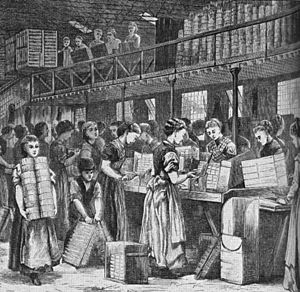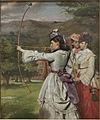Women in the Victorian era facts for kids
| 1837–1901 | |
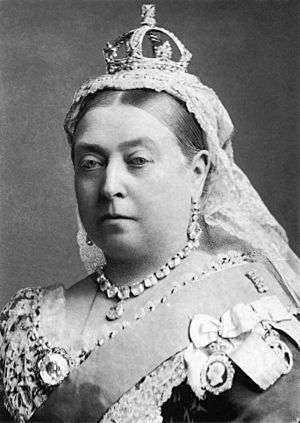
|
|
| Preceded by | Regency era |
|---|---|
| Followed by | Edwardian era |
| Monarch | Queen Victoria |
The Victorian era, named after Queen Victoria who ruled from 1837 to 1901, was a time of great change in Britain. While Britain became very powerful and wealthy, the lives of women were often quite difficult. Many people, both then and now, felt that the way women were treated was unfair.
During this time, women did not have many rights. For example, they could not vote in elections. If a woman was married, she usually could not own property or even keep the money she earned. However, as the Industrial Revolution changed society, more and more women started working outside the home. Ideas about women's rights began to spread, especially among educated women. Towards the end of the Victorian era, some unfair laws were changed, and the movement for women to get the right to vote grew stronger.
In the middle and upper classes, women were often expected to stay at home. Their main jobs were to keep the house clean, cook meals, and raise their children. When a woman got married, she often lost control of her money and most of her belongings.
Before laws like the Married Women's Property Act 1870 and Married Women's Property Act 1882 were passed, married women in Britain had very few legal rights. Under old English laws, a married woman lost her independence. She could not sign contracts or sue anyone. Her property and responsibilities became her husband's. They were seen as one legal person. Any personal items a wife got after marriage usually became her husband's property. She could not sell anything without his permission. If a couple divorced, women usually got no rights to any property they had gained during the marriage, often leaving them poor.
In some other countries, like France, women could keep legal rights to property they owned before marriage. However, under French law, a husband still controlled all family money during the marriage. After a divorce, property gained during the marriage was divided equally.
Victorian women faced many challenges, whether they were single or married. They dealt with unfairness in their marriages and in society. Men had more stability, money, and power in their homes. Marriages were very hard to end, especially without legal help. Women's rights groups fought for equality and slowly gained ground. But many Victorian women had to live with their husbands' control and even cruelty, like verbal abuse or not having enough money. If a husband had a relationship with another woman, his wife could not divorce him for that reason, and divorce was seen as a very bad thing.
Contents
The Ideal Victorian Wife
By the Victorian era, the idea that the husband was the head of the family and its moral leader was very strong in Britain. A wife's main role was to love, honor, and obey her husband, as her marriage vows stated. While her place was below her husband's, it was still seen as very important. Victorians believed that a wife's duties to care for her husband and raise her children properly were key to a stable society.
Victorian culture showed many examples of what an ideal wife should be like. The perfect image of a patient, sacrificing wife is shown in The Angel in the House, a popular poem from 1854 by Coventry Patmore:
Man must be pleased; but him to please
Is woman's pleasure; down the gulf
Of his condoled necessities
She casts her best, she flings herself ...
She loves with love that cannot tire;
And when, ah woe, she loves alone,
Through passionate duty love springs higher,
As grass grows taller round a stone.
The writer Virginia Woolf later described this "angel" as:
immensely sympathetic, immensely charming, utterly unselfish. She excelled in the difficult arts of family life. She sacrificed herself daily ... in short, she was so constituted that she never had a mind but preferred to sympathize always with the minds and wishes of others. Above all ... she was pure. Her purity was supposed to be her chief beauty.
Many books from the Victorian era gave advice on a man's role in the home. For example, a book from 1883 said that making a home happy was not just the wife's job. It said the husband also had a part to play, and if he failed, the home would be unhappy.
Some writers at the time thought that women's special qualities, like being delicate, sensitive, and good at noticing things, made them better at writing stories about home, family, and love. These stories were very popular with middle-class women. However, some early feminists wanted women to have goals beyond just the home. By the end of the century, a "New Woman" appeared. She rode bicycles, wore bloomers, signed petitions, and talked about getting the right to vote. Later feminists did not like the "Angel of the House" idea, as they felt it held women back.
The Household General
The term 'The Household General' was created in 1861 by Isabella Beeton in her famous book Mrs Beeton's Book of Household Management. She explained that the lady of the house was like the commander of an army or the leader of a business. To run a good home and make sure her family was happy and comfortable, she had to do her duties smartly and completely. For example, she had to organize, give tasks to, and teach her servants. This was often hard because many servants were not very reliable.
Isabella Beeton's readers, who were often upper-middle-class, might have had many servants. The lady of the house had to manage all of them. Beeton advised her readers to keep a "housekeeping account book" to track spending. She suggested writing down expenses every day and checking the balance each month. Besides paying servants, the lady of the house also paid tradespeople like butchers and bakers. If a household could afford a housekeeper to manage accounts, Beeton still advised checking their records regularly.
Beeton provided a list of servant roles and their typical yearly pay. "Found in livery" meant the employer provided meals and a work uniform. The large number of servants and their duties show why the lady of the house needed to be good at organizing. Beeton said that a "wealthy nobleman" would have all the servants on this list. Her readers were told to adjust the number of staff and their pay based on their own budget and the servant's experience.
| Servant's position (Male domestics) |
When not found in livery | When found in livery |
|---|---|---|
| House Steward | £10–£80 | – |
| Valet | £25–£50 | £20–£30 |
| Butler | £25–£50 | – |
| Cook | £20–£50 | – |
| Gardener | £10–£30 | – |
| Footman | £20–£60 | £15–£25 |
| Under Butler | £15–£30 | £15–£25 |
| Coachman | – | £20–£35 |
| Groom | £15–£30 | £12–£25 |
| Under Footman | – | £2–£20 |
| Page or Footboy | £8–£18 | £6–£14 |
| Stableboy | £6–£12 | – |
| Servant's position (Female domestics) !! When no extra allowance is made for tea, sugar and beer !! When an extra allowance is made for tea, sugar and beer |
||
| Housekeeper | £20–£45 | £18–£40 |
| Lady's-maid | £12–£25 | £10–£20 |
| Head Nurse | £15–£30 | £13–£26 |
| Cook | £11–£30 | £12–£26 |
| Upper Housemaid | £12–£20 | £10–£17 |
| Upper Laundry-maid | £12–£18 | £10–£15 |
| Maid-of-all-work | £9–£14 | £7 10s.–£11 |
| Under Housemaid | £8–£12 | £6 10s.–£10 |
| Still-room maid | £9–£14 | £8–£13 |
| Nursemaid | £8–£12 | £5–£10 |
| Under Laundry-maid | £9–£11 | £8–£12 |
| Kitchen-maid | £9–£14 | £8–£12 |
| Scullery-maid | £5–£9 | £4–£8 |
The "Household General" was also expected to organize parties and dinners to bring honor to her husband and help him make important connections. Beeton gave very detailed instructions on how to supervise servants for these events. She also explained the rules for sending and receiving invitations, and how to behave at parties. The lady of the house also helped supervise the education of the youngest children. Beeton made it clear that a woman's place was in the home. Her duties there came first. Social activities for herself were less important than managing the household and being her husband's companion. These activities were strictly limited:
After luncheon, morning calls and visits may be made and received.... Visits of ceremony, or courtesy ... are uniformly required after dining at a friend's house, or after a ball, picnic, or any other party. These visits should be short, a stay of from fifteen to twenty minutes being quite sufficient. A lady paying a visit may remove her boa or neckerchief; but neither shawl nor bonnet....
Many advice books on housekeeping and being an ideal wife were popular during the Victorian era. Besides Mrs. Beeton's book, there were Infant Nursing and the Management of Young Children (1866) and Practical Housekeeping; or, the duties of a home-wife (1867) by Mrs. Frederick Pedley. Also, From Kitchen to Garret by Jane Ellen Panton had 11 editions in ten years. Shirley Forster Murphy, a doctor, wrote Our Homes, and How to Make them Healthy (1883).
Working-Class Home Life
Life for a working-class family was much harder. Basic housing standards were a new idea in the Victorian era. A working-class wife had to try to keep her family clean, warm, and dry in homes that were often falling apart. In London, many working-class families lived in very crowded slums. It was common for families to live in just one room. In the worst areas, 90 people might live in a 10-room house, or 12 people in a single small room.
Rents were very high. In London, 85% of working-class families spent at least one-fifth of their income on rent. Half of them paid one-quarter to one-half of their income on rent. Surprisingly, the poorer the area, the higher the rents were. For example, rents in the Old Nichol area were five to eleven times higher per cubic foot than in the nice parts of the West End of London. The owners of these slum homes included rich nobles and church leaders.
For women without servants, housework meant a lot of washing and cleaning. Coal dust from stoves and factories was a huge problem. It was carried by wind and fog, covering windows, clothes, furniture, and rugs. Washing clothes and linens was usually done once a week. They were scrubbed by hand in a large metal tub. Some warm water and a bit of soda were added to soften the water. Curtains were taken down and washed every two weeks. They were often so black from coal smoke that they needed to be soaked in salt water first. Scrubbing the front wooden doorstep every morning was also important to keep up appearances.
Divorce and Women's Legal Rights
The 19th century brought big changes for women, especially in marriage laws and their rights to divorce or get custody of their children. Before, fathers always got custody, leaving mothers with no rights. This slowly began to change.
The Custody of Infants Act 1839 allowed mothers with good character to see their children if they separated or divorced. The Matrimonial Causes Act 1857 gave women limited ways to get a divorce. The Custody of Infants Act 1873 gave all women access to their children after separation or divorce. In 1878, a change to the Matrimonial Causes Act allowed women to separate if their husband was cruel. They could also claim custody of their children. Judges could even give protection orders to wives whose husbands had been found guilty of serious assault.
An important change came with the Married Women's Property Act 1884. This law recognized that wives were not their husband's property. They were independent people. Through the Guardianship of Infants Act 1886, women could become the only guardian of their children if their husband died. Slowly, women's rights changed, allowing them to eventually leave their husbands for good.
Here are some key dates:
- 1857: Violence was recognized as a reason for divorce.
- 1870: Women could keep the money they earned.
- 1878: Women gained the right to receive financial support for themselves and their children.
Education for Girls
Generally, women were expected to marry and focus on home and family duties, not to get a formal education. Even women who did not marry were usually expected to work in childcare, like being a governess, rather than going to university.
Things improved for women seeking education when Queen's College was founded in London in 1848. Its goal was to give governesses a useful education. Later, the Cheltenham Ladies' College and other girls' schools were started. These schools increased educational chances for women. This eventually led to the creation of the National Union of Women's Suffrage Societies in 1897, which fought for women's right to vote.
Women in the Workforce
Working-Class Jobs
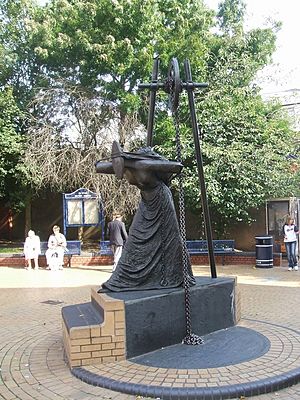
Working-class women often had jobs to help their families survive. They needed to earn money in case a husband got sick, injured, or died. There was no workers' compensation until late in the Victorian era. If a husband was too ill to work, the family might not be able to pay rent and could end up in a dreaded workhouse.
Throughout the Victorian era, some women worked in heavy industries like coal mines and steel factories. Although fewer women worked in these jobs as new laws were passed, they could still be found in certain roles. Before the Mines and Collieries Act 1842, women and children worked underground, pulling tubs of coal through narrow mine shafts. In Wolverhampton, this law did not stop women from mining jobs much, because they mainly worked above ground. They sorted coal, loaded canal boats, and did other surface tasks. Women also traditionally did "all the chief tasks in agriculture" across England, as a government study found in 1843. By the late 1860s, farm work did not pay well, so women moved to factory jobs.
In areas with factories, women could find jobs on assembly lines making things from locks to canned food. Industrial laundries employed many women. Women also commonly worked in the textile mills that grew during the industrial revolution in cities like Manchester. Many working-class women in London worked from home or as "hawkers," selling things like watercress or flowers on the street. Many also worked as washerwomen, doing laundry for others.
Some women earned money by spinning and winding wool or silk at home. However, wages were very low, and hours were long, often 14 hours a day just to earn enough to live. Furniture assembly and finishing were better-paying home jobs. Women were known as skilled "French polishers" who finished furniture. The lowest-paying jobs for working-class women in London were making matchboxes and sorting rags in rag factories. These rags were often full of fleas and lice and were sorted to make paper.
Needlework was the biggest paid job for women working from home. But it paid very little, and women often had to rent sewing machines. These home industries became known as "sweated industries." In 1890, these were defined as "work carried on for inadequate wages and for excessive hours in unsanitary conditions." By 1906, these workers earned about a penny an hour.
Women could not expect to be paid the same as men for the same work. This was true even though women were just as likely as men to be married and supporting children. In 1906, the government found that a woman's average weekly factory wage was 11 to 18 shillings, while a man's was around 25 shillings. Factory owners often preferred women because they could be "more easily induced to undergo severe bodily fatigue than men." Childcare was another cost for many factory-working women. Pregnant women worked until the day they gave birth and returned as soon as they could. In 1891, a law required women to take four weeks off after giving birth, but many could not afford this unpaid time off, so the law was not often followed.
Middle-Class Jobs
As education spread, some ambitious young women from working-class families found salaried jobs in new fields. These included salesgirls, cashiers, typists, and secretaries. Working as a domestic servant, like a maid or cook, was common. However, there was strong competition for jobs in the more respected and higher-paying households. Special agencies helped control the employment of better-qualified domestic servants.
For women from solid middle-class families, respectable jobs were mostly limited to being a schoolteacher or governess. Once telephones became common, working as a telephone operator became a respectable job for middle-class women who needed work.
Three medical jobs opened to women in the 19th century: nursing, midwifery, and being a doctor. However, women were widely accepted only in nursing. This job was most controlled by male doctors. Victorians thought being a doctor was only for men. They believed women should not enter this field but stay in the roles God had given them, as nurses.
Florence Nightingale (1820–1910) was very important in changing the image of nurses. She was seen as a self-sacrificing "Lady with the lamp," bringing comfort to the wounded. She successfully modernized the nursing profession. She promoted training for women and taught them courage, confidence, and self-assertion.
Leisure Activities
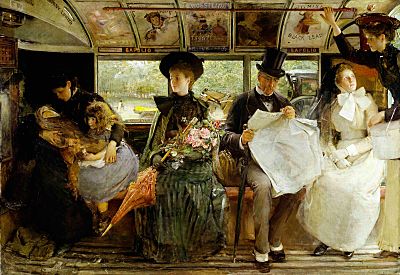
Middle-class women's free time activities mostly included traditional hobbies like reading, embroidery, music, and handicrafts. Upper-class women gave their handicrafts to charity bazaars. This allowed them to show and sell their creations publicly.
More modern activities became available to women in the 19th century. Opportunities for leisure grew a lot as wages increased and work hours decreased. In cities, the nine-hour workday became more common. The 1874 Factory Act limited the workweek to 56.5 hours. This encouraged the move towards an eventual eight-hour workday.
Thanks to the Bank Holiday Act 1871, which created several fixed holidays, annual vacations became common. This started with office workers and then spread to the working class. About 200 seaside resorts appeared because of cheap hotels, inexpensive train fares, and new holidays. Middle-class Victorians used trains to visit the seaside. Many people traveling to quiet fishing villages like Worthing and Scarborough turned them into big tourist centers.
By the late Victorian era, the entertainment industry grew in all cities, with many women attending. It offered scheduled shows at convenient places for low prices. These included sports events, music halls, and popular theater. Women were now allowed to play some sports, such as archery, tennis, badminton, and gymnastics.
Physical Activity
In the early 1800s, many believed that physical activity was dangerous and not proper for women. Girls were taught to save their delicate health for having healthy children. One supposed benefit of the corset was to limit breathing. Also, the physical differences between sexes were used to support social inequality. One writer argued that women were not meant for male roles because they were "physically smaller and weaker than men; their brain is much lighter; and they are in every way unfitted for the same amount of bodily or mental labour that men are able to undertake."
However, by the end of the century, doctors understood the benefits of exercise. This led to a big increase in physical activities for girls. By 1902, The Girl's Empire magazine ran articles on "How to Be Strong." It said, "The old-fashioned fallacies regarding health, diet, exercise, dress, &c., have nearly all been exploded, and to-day women are discarding the old ideas and methods, and entering into the new régime with a zest and vigour which bodes well for the future."
Girls' magazines, like The Girl's Own Paper, often had articles encouraging girls to exercise daily or learn a sport. Popular sports for girls included hockey, golf, cycling, tennis, fencing, and swimming. Of course, many of these sports were only for middle and upper-class girls who could afford the equipment and free time. Still, including girls in physical activities created new ways for them to be seen outside the home. They could take part in activities previously only for boys. Sports became very important to many middle-class girls. Some people worried it would overshadow other cultural interests. For example, a 1902 article complained, "To hear some modern schoolgirls, and even modern mothers, talk, one would suppose that hockey was the chief end of all education!"
However, older ideas connecting girls to motherhood and home life still influenced their development. So, while girls had more freedom, much of their physical activity was still explained as being good for future mothers. Healthy girls would have healthier children, improving the British people. For instance, an early article advising girls to exercise stressed their future role as mothers to support its argument.
Victorian Women's Fashion
Victorian women's clothing followed trends that featured elaborate dresses and wide skirts. These skirts got their volume from layers of material like crinolines, hoop skirt frames, and heavy fabrics. Because these fashions were impractical and sometimes bad for health, a reform movement started among women.
The ideal look of the time required a very narrow waist. This was achieved by tightening the stomach with a laced corset. While the look was striking, and the dresses were often beautifully detailed, the clothes were awkward. At best, they limited women's movements. At worst, they harmed women's health. Doctors studied corsets and found they caused problems like squeezed chests, restricted breathing, organ displacement, poor blood flow, and a prolapsed uterus.
Articles calling for changes in women's clothing from groups like the British National Health Society were reprinted in Canada's medical journal. In 1884, a doctor in Toronto worried that fashions were hurting the health of young working-class women. He noted that a young working woman might spend a lot of her money on fancy hats and shawls, while her "feet are improperly protected, and she wears no flannel petticoat or woollen stockings."
Florence Pomeroy, Lady Haberton, led the Rational Dress movement in Britain. In 1882, she showed her invention: a "divided skirt." This was a long skirt that cleared the ground, with separate halves at the bottom. She hoped it would become popular by giving women more freedom to move. But the British public was not impressed, perhaps because it reminded them of the American Bloomers movement, which was seen as "unwomanly." Amelia Jenks Bloomer had encouraged feminists to wear visible bloomers to show their right to comfortable clothes. This was just a passing fashion among radical feminists.
However, the movement to reform women's dress continued and eventually succeeded. By the 1920s, Coco Chanel successfully sold a new, much less restrictive style that got rid of the corset and raised hemlines. This new look symbolized modernism for trendy young women and became the standard for the 20th century. Other designers continued to reintroduce pants for women, and this trend was slowly adopted over the next century.
Fashion trends came "full circle" during the Victorian era. At the very beginning of Victoria's reign, popular styles were simple, influenced by the flowing gowns of Ancient Greece and Rome. The Empire waist style was replaced by ornate looks and an artificial shape. The most restrictive women's clothing was seen in the mid-century, with tight corsets and hoop skirts. The famous wide-brimmed women's hats of the later Victorian era also showed a trend towards showy display. Hats started as simple bonnets. By the 1880s, hat makers competed to create the most creative and expensive hats, using silk flowers and exotic feathers. As the Victorian era ended, fashions began to show a move away from excessive styles. Model Lillie Langtry became famous in the 1870s for wearing simple black dresses to social events. This style, combined with her beauty, looked dramatic. Fashions followed her example, as well as Queen Victoria's choice to wear mourning black later in her reign.
Fashion Changes Over Time
-
The Gallery of HMS Calcutta by James Tissot (1876). Bustles were popular in the 1870s and 1880s.
-
Mrs. Lillie Langtry by George Frederic Watts (1880).
-
Fashionable women in Queensland, Australia around 1900.
Women in the British Empire
Queen Victoria ruled as the monarch of Britain's colonies and as Empress of India. The influence of British rule and culture was strong throughout the Victorian era. Women's roles in the colonial countries were shaped by loyalty to the Queen and the cultural standards she represented.
Canada
During the Victorian era, most upper-class people in Canada were of British origin. At the start of Victoria's reign, British North America included several separate colonies. These joined together in 1867 to form Canada. Military and government officials and their families came from England or Scotland. Most businesses were controlled by Canadians of British background. English-speaking minorities, like many Roman Catholic Irish and later Ukrainians, struggled for economic and government influence. French-Canadians mostly remained culturally separate from English-speaking Canadians. Visible minority groups, such as Indigenous peoples and Chinese laborers, faced great discrimination. So, a woman's status depended a lot on her ethnic background and her place within the British class system.
English-speaking Canadian writers became popular. This included Catharine Parr Traill and her sister Susanna Moodie. These middle-class English settlers wrote memoirs about their challenging lives as pioneers. Traill published The Backwoods of Canada (1836) and Canadian Crusoes (1852). Moodie published Roughing it in the Bush (1852) and Life in the Clearings (1853). Their stories told of the hard life for women settlers and were very popular.
Upper-class Canadian women copied British culture. They imported as many British books, magazines, music, and theater shows as possible.
Upper-class women supported charity causes, similar to those in England. The Victorian Order of Nurses, which still exists, was founded in 1897 as a gift to Queen Victoria to celebrate her Diamond Jubilee. The Imperial Order of the Daughters of the Empire, founded in 1900, supports education to promote Canadian patriotism and knowledge of the British Empire. Both organizations had Queen Victoria as their official patron.
Women slowly began to gain access to higher education. In 1875, Grace Annie Lockhart became the first woman university graduate in Canada (Mount Allison University). In 1880, Emily Stowe became the first woman licensed to practice medicine in Canada.
Women's legal rights made slow progress throughout the 19th century. In 1859, Upper Canada passed a law allowing married women to own property. In 1885, Alberta passed a law allowing unmarried women who owned property to vote and hold office in school matters.
Women's suffrage (the right to vote) was not achieved until the World War I period. The fight for suffrage began in the later Victorian era. In 1883, the Toronto Women's Literary and Social Progress Club met and formed the Canadian Women's Suffrage Association.
Images for kids
-
Croquet by James Tissot. Croquet was a popular lawn game in Britain beginning in the 1860s.
-
On the Shores of Bognor Regis by Alexander Rossi (artist). Seaside picnics near resort villages in England became accessible to the middle classes later in the Victorian era.
-
A Rally by Sir John Lavery. Badminton and tennis were popular occasions for parties, with women playing "mixed doubles" alongside male players.
See also
- The Edwardian Country House
- Women in early modern Scotland


